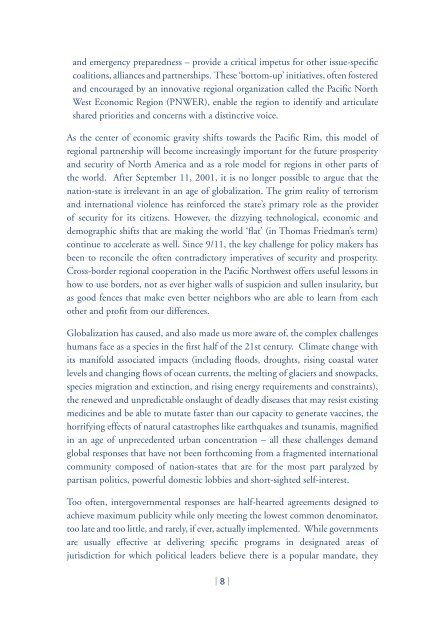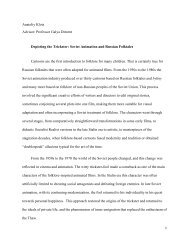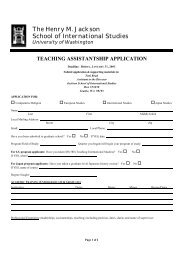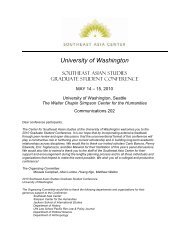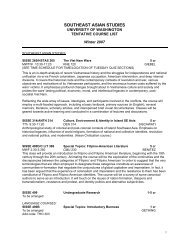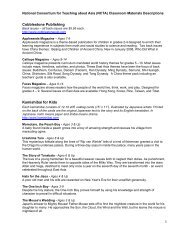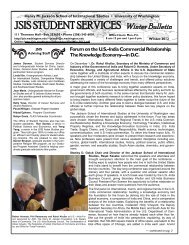Beyond Borders: Regional Partnerships in the Pacific Northwest
Beyond Borders: Regional Partnerships in the Pacific Northwest
Beyond Borders: Regional Partnerships in the Pacific Northwest
Create successful ePaper yourself
Turn your PDF publications into a flip-book with our unique Google optimized e-Paper software.
and emergency preparedness – provide a critical impetus for o<strong>the</strong>r issue-specific<br />
coalitions, alliances and partnerships. These ‘bottom-up’ <strong>in</strong>itiatives, often fostered<br />
and encouraged by an <strong>in</strong>novative regional organization called <strong>the</strong> <strong>Pacific</strong> North<br />
West Economic Region (PNWER), enable <strong>the</strong> region to identify and articulate<br />
shared priorities and concerns with a dist<strong>in</strong>ctive voice.<br />
As <strong>the</strong> center of economic gravity shifts towards <strong>the</strong> <strong>Pacific</strong> Rim, this model of<br />
regional partnership will become <strong>in</strong>creas<strong>in</strong>gly important for <strong>the</strong> future prosperity<br />
and security of North America and as a role model for regions <strong>in</strong> o<strong>the</strong>r parts of<br />
<strong>the</strong> world. After September 11, 2001, it is no longer possible to argue that <strong>the</strong><br />
nation-state is irrelevant <strong>in</strong> an age of globalization. The grim reality of terrorism<br />
and <strong>in</strong>ternational violence has re<strong>in</strong>forced <strong>the</strong> state’s primary role as <strong>the</strong> provider<br />
of security for its citizens. However, <strong>the</strong> dizzy<strong>in</strong>g technological, economic and<br />
demographic shifts that are mak<strong>in</strong>g <strong>the</strong> world ‘flat’ (<strong>in</strong> Thomas Friedman’s term)<br />
cont<strong>in</strong>ue to accelerate as well. S<strong>in</strong>ce 9/11, <strong>the</strong> key challenge for policy makers has<br />
been to reconcile <strong>the</strong> often contradictory imperatives of security and prosperity.<br />
Cross-border regional cooperation <strong>in</strong> <strong>the</strong> <strong>Pacific</strong> <strong>Northwest</strong> offers useful lessons <strong>in</strong><br />
how to use borders, not as ever higher walls of suspicion and sullen <strong>in</strong>sularity, but<br />
as good fences that make even better neighbors who are able to learn from each<br />
o<strong>the</strong>r and profit from our differences.<br />
Globalization has caused, and also made us more aware of, <strong>the</strong> complex challenges<br />
humans face as a species <strong>in</strong> <strong>the</strong> first half of <strong>the</strong> 21st century. Climate change with<br />
its manifold associated impacts (<strong>in</strong>clud<strong>in</strong>g floods, droughts, ris<strong>in</strong>g coastal water<br />
levels and chang<strong>in</strong>g flows of ocean currents, <strong>the</strong> melt<strong>in</strong>g of glaciers and snowpacks,<br />
species migration and ext<strong>in</strong>ction, and ris<strong>in</strong>g energy requirements and constra<strong>in</strong>ts),<br />
<strong>the</strong> renewed and unpredictable onslaught of deadly diseases that may resist exist<strong>in</strong>g<br />
medic<strong>in</strong>es and be able to mutate faster than our capacity to generate vacc<strong>in</strong>es, <strong>the</strong><br />
horrify<strong>in</strong>g effects of natural catastrophes like earthquakes and tsunamis, magnified<br />
<strong>in</strong> an age of unprecedented urban concentration – all <strong>the</strong>se challenges demand<br />
global responses that have not been forthcom<strong>in</strong>g from a fragmented <strong>in</strong>ternational<br />
community composed of nation-states that are for <strong>the</strong> most part paralyzed by<br />
partisan politics, powerful domestic lobbies and short-sighted self-<strong>in</strong>terest.<br />
Too often, <strong>in</strong>tergovernmental responses are half-hearted agreements designed to<br />
achieve maximum publicity while only meet<strong>in</strong>g <strong>the</strong> lowest common denom<strong>in</strong>ator,<br />
too late and too little, and rarely, if ever, actually implemented. While governments<br />
are usually effective at deliver<strong>in</strong>g specific programs <strong>in</strong> designated areas of<br />
jurisdiction for which political leaders believe <strong>the</strong>re is a popular mandate, <strong>the</strong>y<br />
| 8 |


